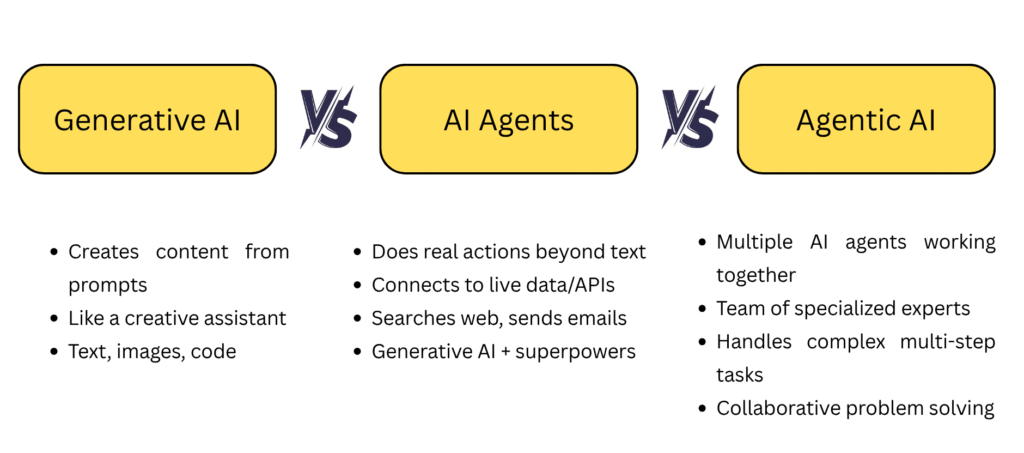The AI landscape can feel overwhelming with all the buzzwords flying around. Today, we’re breaking down three fundamental concepts that are shaping the future of artificial intelligence: Generative AI, AI Agents, and Agentic AI.
By the end of this guide, you’ll understand exactly what each one does, when to use them, and how they’re transforming industries.
What is Generative AI?
Think of Generative AI as a creative assistant that learned from billions of examples and can now create new content on demand.
The Basics
Generative AI is powered by Large Language Models (LLMs) that have been trained on massive amounts of data. When you give them a prompt, they generate new content based on patterns they’ve learned.
Popular Examples:
- ChatGPT – Writes essays, explains concepts, codes programs
- DALL-E – Creates images from text descriptions
- GitHub Copilot – Generates code snippets
- Midjourney – Produces artistic images
How Generative AI Works
graph LR
A[Your Prompt] --> B[AI Model]
B --> C[Generated Content]
style A fill:#e3f2fd
style B fill:#fff3e0
style C fill:#e8f5e8The Process:
- You provide a prompt (question, request, or instruction)
- The AI processes it using its training knowledge
- It generates new content as a response
What Can Generative AI Create?
- Text Content: Blog posts, emails, stories, poetry
- Visual Content: Logos, artwork, product mockups
- Code: Python scripts, web pages, mobile apps
- Audio: Music compositions, voice narrations
- Marketing Materials: Ad copy, social media posts
Real-World Example
Prompt: “Write a product description for eco-friendly water bottles”
Generated Output:
“Discover our premium eco-friendly water bottles, crafted from 100% recycled materials. Perfect for outdoor adventures, these leak-proof bottles keep drinks cold for 24 hours and hot for 12 hours. Available in 5 vibrant colors, each purchase removes 10 plastic bottles from ocean waste.”
Understanding AI Agents
AI Agents are like Generative AI with superpowers – they can actually DO things beyond just generating text.
The Problem with Basic AI
Regular Generative AI has limitations:
- ❌ Can’t access current information
- ❌ Can’t connect to databases
- ❌ Can’t perform real actions
- ❌ Only knows training data (no live updates)
How AI Agents Solve This
AI Agents combine the creative power of LLMs with the ability to use external tools and services.
graph TD
A[User Request] --> B[AI Agent]
B --> C{Need External Info?}
C -->|Yes| D[Call External Tool]
C -->|No| E[Use LLM Knowledge]
D --> F[Get Live Data]
F --> G[Process & Respond]
E --> G
G --> H[Final Answer]
style B fill:#fff3e0
style D fill:#e8f5e8
style F fill:#e3f2fdAI Agent Capabilities
What They Can Do:
- Search the internet for current information
- Query databases and APIs
- Send emails or messages
- Make calculations with live data
- Book appointments
- Process files and documents
Real-World Example: Travel Planning Agent
Your Request: “Plan a 3-day trip to Tokyo for next month”
Agent’s Actions:
- Weather Tool: Checks Tokyo weather forecast
- Flight API: Searches for flight prices
- Hotel API: Finds available accommodations
- Maps API: Identifies top attractions
- LLM Processing: Creates personalized itinerary
Result: A complete travel plan with current prices, weather-appropriate activities, and bookable options.
What is Agentic AI? 🔗
Agentic AI is like having a team of specialized AI experts working together on complex projects.
The Power of Teamwork
Instead of one AI doing everything, Agentic AI uses multiple specialized agents that collaborate and communicate to solve complex problems.
How Agentic AI Works
graph TD
A[Complex Task] --> B[Task Coordinator]
B --> C[Agent 1: Research]
B --> D[Agent 2: Analysis]
B --> E[Agent 3: Writing]
B --> F[Agent 4: Review]
C --> G[Share Findings]
D --> G
E --> G
F --> G
G --> H[Final Solution]
style B fill:#fff3e0
style C fill:#e8f5e8
style D fill:#e3f2fd
style E fill:#fce4ec
style F fill:#f3e5f5Comprehensive Example: E-commerce Product Launch
Let’s say you want to launch a new smartphone case. Here’s how Agentic AI would handle it:
Agent Team Structure:
- Market Research Agent
- Analyzes competitor products
- Studies customer reviews
- Identifies market gaps
- Content Creation Agent
- Writes product descriptions
- Creates marketing copy
- Develops social media content
- Design Agent
- Generates product mockups
- Creates packaging designs
- Produces marketing visuals
- Strategy Agent
- Develops pricing strategy
- Plans launch timeline
- Coordinates other agents
The Collaboration Process:
sequenceDiagram
participant U as User
participant C as Coordinator
participant R as Research Agent
participant W as Writing Agent
participant D as Design Agent
participant S as Strategy Agent
U->>C: "Launch smartphone case"
C->>R: Research market
R->>C: Market insights
C->>W: Create content (with research)
C->>D: Design visuals (with research)
W->>S: Content for strategy input
D->>S: Designs for strategy input
S->>C: Complete launch plan
C->>U: Comprehensive solutionWhen Should You Use Each Approach?
Choose Generative AI When:
Perfect For:
- Creating blog posts or articles
- Generating creative content
- Writing code snippets
- Brainstorming ideas
- Educational explanations
Example Use Cases:
- Content marketing teams creating social media posts
- Students getting help with homework explanations
- Developers generating boilerplate code
- Writers overcoming creative blocks
Choose AI Agents When:
Perfect For:
- Customer support with live data access
- Personal assistants that need real-time info
- Task automation requiring external services
- Research that needs current information
Example Use Cases:
- E-commerce chatbot checking inventory levels
- Financial advisor agent accessing market data
- HR assistant scheduling interviews
- Research assistant gathering latest news
Choose Agentic AI When:
Perfect For:
- Complex business processes
- Multi-step project management
- End-to-end automation
- Tasks requiring diverse expertise
Example Use Cases:
- Complete marketing campaign development
- Software development lifecycle automation
- Business intelligence and reporting systems
- Educational curriculum development
Best Practices
Design Principles:
- Start simple and add complexity gradually
- Define clear roles for each agent
- Implement proper error handling
- Monitor and log agent interactions
Performance Optimization:
- Use appropriate model sizes for each task
- Implement caching for repeated operations
- Set reasonable timeout limits
- Plan for API rate limiting
Conclusion
The journey from Generative AI to AI Agents to Agentic AI represents the evolution from creative tools to intelligent assistants to collaborative AI teams.
Key Takeaways:
- Generative AI excels at content creation and creative tasks
- AI Agents add real-world capabilities and external integrations
- Agentic AI enables complex, multi-step business process automation
The future belongs to organizations that can strategically implement these technologies, starting with simple applications and gradually building more sophisticated systems.
Your Next Step: Pick one repetitive task in your work or personal life and explore how AI could help automate or enhance it. Start simple, learn from the experience, and gradually tackle more complex challenges.
The AI revolution isn’t coming—it’s here. The question isn’t whether to adopt these technologies, but how quickly you can learn to leverage them effectively.

